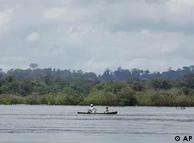Course:ECON371/UBCO2011WT1/GROUP6/Article1
Concerns about methane plague Brazil's Belo Monte dam
http://www.dw-world.de/dw/article/0,,15367464,00.html

Summary
Brazil has started construction on what will be the third largest hydroelectric dam in the world. The Belo Monte dam will have the potential to produce 11,000 megawatts. The dam will be built right by the Amazon by diverting 80% of the Xingu River and flooding 100,000 Hectares of rainforest. The Brazilian government has been receiving much flack over the project, especially with an estimated 40,000 people having to be uprooted from their homes due to increasing water levels to form the reservoir causing extensive flooding. Now, recent research has come out saying that the flooding will lead to a release of carbon and methane that was stored in the trees and produced as they rot. Philip Fearnside, with the National Institute for Amazon Research in Manaus, believes the government will need to build a second dam to meet the increasing power demand. These two dams will omit 11.2 million tons of carbon per year, and the project will have a climate break even time of 41 years. On top of these large projects another 200 smaller dams have been planned in Brazil alone; leaving more chances to disrupt water flow and higher methane production.
Analysis
The main topic analysis that could be done is finding the optimal number of dams to build, and which dams are most efficient financially, and which are most efficient environmentally. The article mentions that the 81 smallest dams will only produce 1,340 MW annually. Compare this to the 11,000 MW that the Belo Monte will produce, and you can see how small the production is. The article also mentions that the smaller operations will be in more shallow water, which produces methane gasses more easily. This would mean that the smaller projects have a worse efficiency in output per unit of environmental damage. Alternative methods of damming to minimize environmental impact could also be taken into consideration. Successively damming the same river would allow all downstream dams to harness the potential energy from the first reservoir without the need to flood additional land and increase the methane and carbon production. A clear definition of all costs needs to be compiled; aggregate marginal abatement costs for all dams production of methane, relocation 40,000 people, loss of cultural sites of indigenous peoples, costs to cover farmers for loss of water due to changing water flows, loss of nutrients due to sediment pile up in dams as well as any other costs or losses. This will give the net externality which added to actual operating costs can show a better picture of the amount each additional unit of production will cause. Compare this to the demand curve and it should lower the total number of projects, had the government not taken into count any externalities. Next a cost benefit analysis should be done of all projects to determine which ones return the highest benefit and can remove the projects with negative benefit. On top of this the equimarginal principal should be applied to all projects to see which ones have the lowest marginal abatement costs and can reduce the most methane efficiently.
Conclusion
Brazil's continued focus on hydroelectric dams as their primary source of power is noble in its attempt; however as Marcello Salazar states in the article "even if the government proceeds with the construction of this wave of hydroelectric projects, it should conduct thorough environmental research and respect the rights of everyone affected." The dams can have massive environmental repercussions and additional externalities by uprooting Brazilian citizens, especially indigenous populations that are relying on current water systems and surrounding rainforest for survival.
Professor's Comment
A well done CBA would be a good idea. You've listed quite a few of the things that should be included.
One issue for projects like this is equity. Will the people relocated be better off or worse off after the project? Did they have any say, or are they being forced to move?
Another question is whether the current plan is economically efficient. Are the decision makers likely taking all the costs and benefits into account, or are there political/social/information pressures that would prevent them from doing so?
8/10